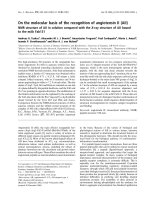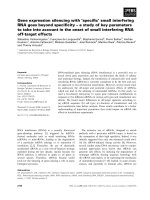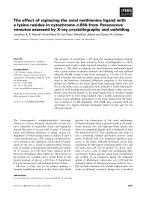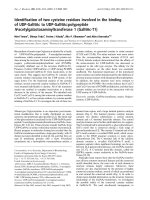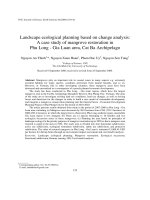The cult of goddess in Phú Quốc island from the worship of water goddess to the mother goddess
Bạn đang xem bản rút gọn của tài liệu. Xem và tải ngay bản đầy đủ của tài liệu tại đây (730.98 KB, 10 trang )
Religious Studies. N0.01 & 02 - 2015
100
TRẦN THỊ AN *
THE CULT OF GODDESS IN PHÚ QUỐC ISLAND
FROM THE WORSHIP OF WATER GODDESS
TO THE MOTHER GODDESS
Abstract: Phú Quốc island as well as Phú Quốc district is a part of
Kiên Giang province. The Phú Quốc’s natural landscape is so
beautiful and it has a diversity of terrain. For living in this island,
people have to adapt to the sea and depend on the sea. Their
adaptation and dependence leads to the love and the gratitude to
the sea, and it becomes the symbol of spiritual life. The islanders’
gratitude is manifested by the cult of the Goddess is called Bà
(Lady) and the placeof worship is also called Dinh Bà (Mansion of
Lady). This article initially examines the Dinh Bà system and the
cult of the Goddess on Phú Quốc island.
Keywords: Cult of Mother Goddess, cult of Water Goddess, cult of
Bà-Cậu, Dinh Bà, Dinh Cậu, Phú Quốc Island, Kiên Giang
province.
1. An overview of the Dinh Bà system on Phú Quốc island
There are four Dinh Bà temples on Phú Quốc island such as Dinh Bà
Dương Đông, Dinh Bà Ông Lang (or Dinh Bà Lớn Tướng), Dinh Bà
Hàm Ninh, Dinh Bà Cửa Cạn. These monuments are situated in 3
residential areas of the 5 total areas.
Dinh Bà Dương Đông temple (Zone 1, Võ Thị Sáu street, Dương
Đông town) faces the sea, at the bottom of the Dinh Cậu mountain.
Beside the Thủy Long Thánh Mẫu (Mother Goddess of Water), this
monument is also dedicated to Tiền hiền (Forefathers) on the right side
and Hậu hiền (Sages) on the left side. The Thủy Long Thánh Mẫu’s altar
is similar to Tứ Phủ (Four Mother Goddesses). According to the layout of
this temple, there is the integration of the cult of the Mother Goddesses
into the cult of Tiền hiền and Hậu hiền (the Gods taught the method of
*
Ass. PhD., Vietnam Academy of Social Sciences.
Trần Thị An. The Cult of Goddess in Phú Quôć ...
101
land reclamation and cultivation to people) and these cults are the basis
for establishing the cult of the Patron god of the village from the Center
to the South of Vietnam. On the left, there is also a closet to store clothes
offered by people.
Basing on some data, Dinh Bà Dương Đông (along with Dinh Bà
Cửa Cạn) worship the Kim Giao Lady. According to the legend that a
princess of the Khmer Kingdom had merits of the reclamation Phú
Quốc island. Whereas Trương Thanh Hùng stated that Dinh Bà Dương
Đông is dedicated for the Thủy Long Thánh Mẫu, it is called Dinh Bà
Ngoài in order to distinguish Dinh Bà Trong where worshiping Kim
Giao1. Ms. Ngọc Lệ (a temple custodian) gave the evidence to prove
this argument. There is a well decorated book with the title “Thủy Long
Thánh Mẫu” (appendix “the anniversary of the reconstruction on 18th
October 1970, the year Canh Tuất) that is preserved in the temple. This
historical data helps to confirm that this relic worships Thánh Mẫu, at
least since 1970. In addition, there are a pair of parallel sentences (câu
đối) on the door of Thánh Mẫu worship space such as “Siêu tứ thủy dĩ
vi vương công năng phối địa/ Mại quần long nhi lập cực đức khả tham
thiên” (Crossing the four seas to become the king, the merits are on par
with the Earth/ Higher than a dragon herd, the morality is on par with
the Sky). This pair of parallel sentences uses two words “Thủy” and
“Long” to indicate the name of the Thủy Long Mother Goddess and it
praises the merits of the Goddess.
Dinh Bà Ông Lang temple (Ông Lang village, Cửa Dương commune)
is situated near the coast in the north of the Phú Quốc island. Although it
is located on a large site, but the worship space is a small chamber.
According to the horizontal lacquered board (đại tự) on the door, this
relic was built in 1946 and it was reconstructed in 2007 with a new
architecture style. This temple is dedicated to Mrs. Lê Kim Định or Mrs.
Grand General (Bà Tướng Lớn). The throne is layout by a statue with
colorful clothes and necklaces. There is the portrait of Nguyễn Trung
Trực on the left side. There are two sentences “Anh hùng dân tộc” (The
national hero) and “Trung trinh liệt nữ” (The fidelity of a female who
sacrificed heroically). There is also a closet to store clothes which were
offered by people. In addition, on the yard, there are two statues of Quan
Âm Nam Hải (Nanhai Guanyin Buddha or Mercy Goddess) face the sea.
102
Religious Studies. N0.01 & 02 - 2015
According to the legend Mrs. Lê Kim Định was the wife of the national
hero Nguyễn Trung Trực. She and her husband participated in the
resistance war against French colonists. She was honored as a Mrs. Grand
General. Her tomb is at the edge of the sea and far from her temple.
Dinh Bà Hàm Ninh (Dinh Bà Thủy Long Thánh Mẫu) temple is
located in Hàm Ninh commune. According to local people, this temple
was formerly situated near the coast, but it was moved to this place
because of the landslide.
There are two chambers for worshiping Dinh Ông Nam Hải and Dinh
Bà Thủy. In addition, on two sides of the yard, there are two shrines for
Cô and Cậu as the cult of Tứ Phủ. The Dinh Ông Nam Hải worship
chamber has a skeleton of Cá Ông (Whale) and the Dinh Bà Thủy is
divided into two parts; the front part has an incense bowl and two
flamingos; the behind part has a statue of the Mother Goddess. There are
two wooden boats and some sea products at two sides of the altar. On the
left, there is also a closet to store clothes offered by people. Some of
these clothes will be dressed for the Goddess on the festival (night of the
day 22nd or 23rd, Third month, according to the Lunar year).
In the front of Bà Thủy worship chamber has a wooden board carved
the word “Tâm” (the heart) and a sentence “A good day, the top of the
Third month, the year Quý Mão, the title of the Quang Tự king (1903),
believers are Hoàng Ứng Tinh, Hoàng Khánh Vân, Hoàng Đắc Lan and
Quách Viễn Phiên from Hải Nam island worshiped”. This data shows
that this board offered by people of Hải Nam island. Perhaps, they were
blessed by the Mother Goddess, then they came back to thanksgiving.
According to this document, the Dinh Bà Hàm Ninh has been a sacred
temple at least since the beginning of the 20th century.
The worship objects of the Dinh Bà Hàm Ninh are Nam Hải (Cá Ông)
and Bà Thủy (Thủy Long Thánh Mẫu). According to Mr. Võ Vạn, Thủy
Long Thánh Mẫu is Thiên Ya Na or Mrs. Marian Jade Lord. Local people
organized a procession the Lord from Khánh Hòa province. The
procession day of the Lord was also the day of Nam Hải died, so it
became the festival day.
Dinh Bà Cửa Cạn temple is located on the right bank of Cửa Cạn river.
According to the legend, this temple is dedicated to Kim Giao, a princess
of the Khmer Kingdom had merits of the reclamation Phú Quốc island.
Trần Thị An. The Cult of Goddess in Phú Quôć ...
103
To sum up, in general, the cult of the Goddess (Bà) and the construction
of Dinh is a long process; it is a need of the spiritual life of the Phú Quốc
islanders. They attempted to co-exist with new environment and society.
This cult was precious in the spiritual life of people on the new isolated
land among the sea. Besides, the cult of Bà of the Phú Quốc islanders
showed the integration of belief in many domains. Although the cult of Bà
was determined, but it has been an opened system to receive new nuances
of islanders’ spiritual life until now.
2. The cultural layers in the cult of Bà on Phú Quốc island
The introduction of the Dinh Bà system on the Phú Quốc island shows
the cultural layers interwovenin the spiritual life of islanders as:
2.1. The cult of Sea God
Almost of people practice the cult of Bà are fishermen. As a result of
our survey on June 2013, most of ship owners have belief in the blessings
(support and protection) of the Gods at the worship places that were
mentioned. When going fishing, they may do not come to Dinh Bà to
pray and worship because there is an altar of the Quan Âm Nam Hải
(Nanhai Guanyin Buddha) on all their ships. However, they always pray
to the Gods when their ships cross these worship places. Mr. Võ Vạn, a
member of the management council of the Dinh Bà Hàm Ninh relic,
stated that “The local people are pious. During the memory day of her
death, all people return to the island to worship despite they are fishing
anywhere. With the support and protection of Nam Hải, fishermen can
catch many fish and the Goddess also helps to tow the sunk ships into the
land. The Goddess blesses the health or whatever someone pray for
fishermen, small traders, the poor or the childless”. (Interview the 5th
June, 2013).
There is a worship chamber of Nam Hải in Dinh Bà Hàm Ninh relic.
In Dinh Bà Ông Lang’s yard has two statues of Quan Âm Nam Hải
(Nanhai Guanyin Buddha). In addition, the pair of parallel sentences (has
mentioned) of Dinh Bà Đông Dương temple showed the praise from Phú
Quốc islanders for the king of the sea. Furthermore, a pair of parallel
sentences of the Dinh Cậu temple also indicated the same emotion as
“Phong điều vũ thuận dân an lạc/ Hải yến hà thanh thế thái bình”
(Harmonious rain and wind, people live in peace and happiness/ Calm
river and sea, lives are peaceful). Their desires for harmonious rain and
104
Religious Studies. N0.01 & 02 - 2015
wind and calm river and sea are permanent of sea inhabitants, so their
spirituality rely on the God of the Sea.
In addition, there are two worship places of Thủy Long Thánh Mẫu in
Dinh Bà relics in the Phú Quốc Island. It shows that the cult of the God
of the Sea in Dinh Bà relics is clarified.
2.2. The cult of land reclamation God
Dinh Bà Dương Đông and Dinh Bà Cửa Cạn temples are dedicated
to the Kim Giao Lady. According to the legend that Kim Giao had
merits of the reclamation Phú Quốc island and taught people to
cultivate. At present, Dinh Bà Cửa Cạn area has had vestiges of field
reclaimed by Kim Giao with many pillars to tie buffaloes since once
upon a time. And Dinh Bà Dương Đông temple has had traces of the
cult of the God of reclamation. There are altars of Tiền hiền
(Forefathers) and Hậu hiền (Sages) in this monument. The worship of
the person who has had merits for reclaiming has originated from the
Center and the South of Vietnam.
2.3. The cult of historical characters
There is a popular phenomenon in the belief of the Vietnamese as
“Legends were attached to historical events in order to legitimate the
characters” in reverse “Historical characters were deified with
mysteries”. These tendencies were intertwined, so we can find many
legendary characters in the history and many historical characters have
been honored as divine.
The cult of the Lady Lê Kim Định (wife of the national hero Nguyễn
Trung Trực) is one of the characteristics of the Vietnamese spirituality.
The history book wrote the victory of Nguyễn Trung Trực, but it did not
mention his wife. However, because of the adherence Nguyễn Trung
Trực with the Phú Quốc island the last two years of his life (1885 1886), islanders wrote other historical part of his life with the legend of
the Lady Lê Kim Định. This legend has not only been transmitted at the
Nguyễn Trung Trực temple and it has also integrated with the cult of Bà
Thủy at Dinh Bà Ông Lang temple. The worship of two characters (a
historical character, an unofficial historical character) has created the
attachment the islanders’ lives and the history of resistance to foreign
invaders.
Trần Thị An. The Cult of Goddess in Phú Quôć ...
105
3. The cult of Bà on the Phú Quốc island: reunion and expansion
of the Mother Goddess cult
3.1. The cult of Bà - Cậu
When mentioning the cult of Bà of the Phú Quốc islanders, we could
not help indicating the cult of Bà - Cậu. This cult was written in research
of Huỳnh Tịnh Của, Nguyễn Thanh Lợi (2004 and 2012)2, Dương Hoàng
Lộc (2010)3, and Trương Thanh Hùng (2012)4 .
Trương Thanh Hùng wrote that “most of the people attached their
lives in water believe in “Bà Cậu” cult. They think that this God has
extreme authority that dominates the life and the livelihood of people
depended their lives on the sea and the river (fishermen and traders).
However, many people do not understand Bà Cậu who are two persons or
one person. They only know that if Bà Cậu bless they will have success
in their business and safety. The symbol of Bà Cậu may be Thiên Hậu
(for Chinese), Chúa Liễu, Thủy Long Thánh Mẫu, a prince of Long
Vương, a God of Water, or unknown people who bless for the people
attached their lives with water, etc.. There is an altar of Bà Cậu with
tablet written in the Sino characters as “Thủy Long Thánh Mẫu” or
“Thánh Mẫu Nương Nương” on the ship. Thus, Bà Cậu is not yet two
Gods as Bà and Cậu; it is the God of Bà Cậu. However, there is a
distinguish Bà and Cậu with Miễu Bà (Bà shrine) and Dinh Cậu (Cậu
temple) on the land. According to Trương Thanh Hùng, Huỳnh Tịnh Của,
the origin of this cult “Bà-Cậu are three Bà and seven Cậu attached the
cult of Princess Liễu Hạnh (the Mother Goddess Liễu Hạnh)5.
However, there are other ideas of Dương Hoàng Lộc, Nguyễn Thanh
Lợi, and Nguyễn Văn Minh - a custodian of the temple Dinh Cậu stated that “Bà is Bà Thủy, Cậu are Cậu Tài and Cậu Quý. Dương
Hoàng Lộc emphasized that “in particular, people, in the South, who
have the careers related to water, river, and sea usually worship Bà Cậu
with the desire that they pass over typhoons. Thus, the fishermen and
traders are called dân Bà Cậu (“dân” means inhabitant). Bà Cậu are Bà
Thủy and her sons: Cậu Tài and Cậu Quý”. Nguyễn Thanh Lợi stated
that “the Bà Cậu cult of Bà Rịa - Vũng Tàu inhabitants; Bà Cậu are Bà
Thủy, Cậu Tài and Cậu Quý. Ms. Ngọc Lệ, a custodian of the temple
Dinh Bà Đông Dương, stated that “Bà is Thủy Long Thánh Mẫu; Cậu
are Cậu Tài and Cậu Quý”.
106
Religious Studies. N0.01 & 02 - 2015
Nguyễn Thanh Lợi (2004) and Dương Hoàng Lộc (2010) said that
“Cậu Tài and Cậu Quý were the sons of Thiên Ya Na Diễn Ngọc Phi,
and this context, Thiên Ya Na was homogenized Bà Thủy. Nguyễn
Thanh Lợi wrote that “Chúa Tiên (Chúa Ngọc) had two sons as Cậu Tài
and Cậu Quý; they were the Gods who protect the water area. The
fishermen and traders homogenized Pô Nưgar and Thủy Long Thánh
Phi, along with her sons (Cậu Tài and Cậu Quý) who were the Gods
ruledislands andisletson the seas or rivers”. According to Dương Hoàng
Lộc, “people think that Bà Thủy was Thiên Ya Na incarnated. The stele
written by Phan Thanh Giản in Tháp Bà Nha Trang wrote that Thiên Ya
Na magicked a strong wave to sink the ship of a Chinese Prince and this
ship became a rock. Thus, Thiên Ya Na and her sons (Cậu Tài and Cậu
Quý) were considered the Gods of sea, river, islets”. However,
according to the stele that written by Phan Thanh Giản in 1856 and the
legend of the Khánh Hòa area, Thiên Ya Na had two children, a son and
a girl. The son named Trí and the girl named Quý. Therefore, there was
the appearance of a new character Cậu Tài. The origin of Cậu Tài did
not mention in the legend.
We also find out a complex entity that is Dinh Cậu temple on the
Phú Quốc island. In the relic Dinh Cậu (Cậu means a boy) there is
tablet of Chúa Ngọc Nương Nương (Thiên Ya Na), and two tiny
statues were written Nhị hiền vương Thái tử (according to the legend
they were Cậu Tài, Cậu Quý - Thiên Ya Na’s sons). However, Mr.
Nguyễn Văn Minh, a custodian of the temple, explained that “Cậu Tài
and Cậu Quý were two natural Gods who have come since 2000 years,
a God ruled all seas and the other ruled the navel of the sea. These
Gods had not yet come back the Sky because there were many pirates
and typhoons. Besides, they had to manage the fish around the Phú
Quốc island”. Thus, according to this legend, they were the natural
Gods and they had no relation with Bà Thủy, Bà Thiên Ya Na or Bà
Thủy Long Thánh Mẫu.
Nguyễn Thanh Lợi (2012) also mentioned the other legend that “at the
Côn Đảo island, Bà was homogenized Bà Yến Phi (Lê Thị Răm), a
concubine of Nguyễn Ánh; she was the mother of the Prince Cải; Cậu
was homogenized the prince Cải who was thrown to the sea (when he
was four years old) by the first king of Nguyễn dynasty6.
Trần Thị An. The Cult of Goddess in Phú Quôć ...
107
In my opinion, the legends of Bà and Cậu showed the flexibility and
they were the result of an opened cult and this cult has continuously
received new layers in order to create a larger and unifiedentity.
3.2. From the cult of Sea Goddess to the cult of Mother Goddess
The Dinh Bà temples on the Phú Quốc island are located near the
coast as I have mentioned. These temples’ location is not a random
placement. It meets the spiritual need of fishermen who ask for the Gods’
blessing. According to my data of interview, fishermen believe in
Goddesses (Các Bà) and they usually come these temples to pray before
going to the sea, give thanks for the Goddesses when they have success
in business, participate in the festival day (Vía Bà). In this aspect, the
Goddesses are considered as Bà Thủy, Bà Kim Giao, Bà Lớn Tướng Lê
Kim Định who protect and bless people on the sea.
In addition, according to my data of survey, believers who come to
pray at Dinh Bà and Dinh Cậu belong to many classes. Ms. Tư (Ngọc
Lệ), a custodian of the Dinh Bà Dương Đông temple, and Ms. Trần Thị
Ngân, a member of the Society of the Dinh Bà Dương Đông, stated that
“a half of believers who come to pray at Dinh Bà are tourists or people
from the mainland who arrive to pray for security (cầu an) and avoiding
unlucky or dangerous things (giải hạn). In particular, this kind of tourists
or people only practice the rite at Dinh Bà; people who have careers
related to the sea practice the worship of Bà-Cậu. Besides, people come
Dinh Bà and Dinh Cậu in order to invoke to have children, disease
treatment, success in studying or trading.
According to local people, Mr. Nam Hải blesses the fishermen to
catch many fish, leads the sunk ship to the land. Bà Thủy protects the
poor fisherman, the childless, traders, etc.. It is similar to the case Dinh
Cậu (dedicated to the Sea God)7 and Dinh Bà Dương Đông. While
fishermen pray the blessing from the Gods at Dinh Bà and Dinh Cậu,
people pray for security (cầu an) and avoiding unlucky or dangerous
things (giải hạn) at Dinh Bà. This phenomenon does not show the level of
sacredness, but it is an opened cult. While the cult of Long Vương or
Nam Hải meet the need of protecting people who work on the sea, the
cult of Bà Thủy continuously opens along the time in order to meet
spiritual requirement of people.
108
Religious Studies. N0.01 & 02 - 2015
To sum up, the cult of the Sea Goddess has opened to become a new
complex cult as the cult of the Mother Goddess (Thánh Mẫu) because
this is a unique cult can meet demand of daily life. It also shows the
opened characteristic of the Mother Goddess’ cult (Tứ Phủ). For instance,
the first Medium rite was organized at Dinh Bà Thủy Long Thánh Mẫu
on August 2013 which was welcomed by the inhabitants8.
4. Conclusion
The cult of the Mother Goddess expressed the intensity of spiritual
demand of the Phú Quốc islanders. Basing on the author’s data survey,
the establishment and expansion of this cult, the practice of the rite and
the expansion of the festival at Dinh Bà temples clearly showed the
spiritual requirement of inhabitants. Their desire was manifested
through institutional relic, festival organization, practice of the rite,
belief in magic.
The cult of the Goddess in Phú Quốc island originated from the cult of
the Water Goddess (Bà Thủy) with the desire for safety on the sea of
islanders. However, along with the time, the practice of the rite, the
object and the content of worshiping have been more diverse and this cult
was asymptotic the cult of the Mother Goddess which has had the
flexibility and the synthesis, so it has attracted many classes of islanders
and tourists.
The legends, Dinh Bà and Dinh Cậu temples and the cultural relics in
Phú Quốc island have shown the cultural interleaving of Viet, Chinese,
Khmer, and Cham people. This interleaving has blended perfectly and it
has been become the common property of islanders at present.
It is clear that the cult of Bà-Cậu of the Phú Quốc islanders was an
interleaving between the spirituality of fishermen from the South Central
Coast (Nam Trung Bộ) such as Quảng Ngãi, Bình Định provinces with
the faith of inhabitants of the Southwest Vietnam (Tây Nam Bộ) and the
cult of Tứ Phủ from the North Vietnam (Bắc Bộ). It has gradually
become a system of complex entity. This system has been opened to fulfil
spiritual need of the inhabitants and the rapid change of inhabitants’
spiritual requirement under the social, economic impacts and the
influence of international integration in the contemporary Vietnam./.
Trần Thị An. The Cult of Goddess in Phú Quôć ...
109
NOTES:
1 Trương Thanh Hùng & Phan Đình Độ (2012), The Folklore of Phú Quốc and Lý
Sơn Islands [Văn hóa dân gian huyện đảo Phú Quốc và Lý Sơn], The National
Culture Publishing House, Hanoi: 90.
2 Nguyễn Thanh Lợi (2004), “The Cult of Goddess in Bà Rịa - Vũng Tàu”, in
Research on the Characteristics of Cultural Relics, Folklore of Southern
Vietnam [Tín ngưỡng thờ nữ thần ở Bà Rịa - Vũng Tàu, trong Tìm hiểu đặc
trưng di sản văn hóa văn nghệ dân gian Nam Bộ], The Social Sciences
Publishing House, Hanoi: 146.
3 Dương Hoàng Lộc (2010), “The Cult of the Water Goddess of Fishermen in An
Thủy, Ba Tri district, BếnTre province” [Tín ngưỡng thờ Bà Thủy của cộng đồng
ngư dân An Thủy (huyện Ba Tri, tỉnh Bến Tre], Nguồn sáng Dân gian, số 2.
4 Trương Thanh Hùng & Phan Đình Độ (2012), The Folklore of Phú Quốc and Lý
Sơn Islands, ibid.
5 Trương Thanh Hùng & Phan Đình Độ (2012), The Folklore of Phú Quốc and Lý
Sơn Islands, ibid.
6 Nguyễn Thanh Lợi (2012), “The Story of the Lady Phi Yến in Côn Đảo”, The
conference: Côn Đảo - 150 years of Struggle, Construction and Development,
August. [“Câu chuyện bà Phi Yến ở Côn Đảo”, Hội thảo Côn Đảo - 150 năm đấu
tranh, xây dựng và phát triển].
7 Nguyễn Thị Diệp Mai (2013), “The Cult of Bà in Phú Quốc”, The conference:
The Cult of the Water Goddess - Dragon and Shadow Theater or Sing Writer on
the 10th August. [Tục thờ Bà ở Phú Quốc”, Tọa đàm Văn hóa tín ngưỡng Mẫu
Thoải - Thủy Long và nghi lễ chầu văn tại Phú Quốc.
8 The Performance of Shadow Theater or Sing Writer in Ngọc Island,
ngiang Department of Culture - Sport and Tourism [Trình diễn
nghệ thuật hát chầu văn trên đảo Ngọc], website Sở Văn hóa - Thể thao và Du
Lịch tỉnh Kiên Giang].
REFERENCES:
1. Trương Thanh Hùng & Phan Đình Độ (2012), The Folklore of Phú Quốc and Lý
Sơn Islands [Văn hóa dân gian huyện đảo Phú Quốc và Lý Sơn], The National
Culture Publishing House, Hanoi: 90.
2. Nguyễn Thanh Lợi (2004), “The Cult of Goddess in Bà Rịa - Vũng Tàu”, in
Research on the Characteristics of Cultural Relics, Folklore of Southern
Vietnam [Tín ngưỡng thờ nữ thần ở Bà Rịa - Vũng Tàu, trong Tìm hiểu đặc
trưng di sản văn hóa văn nghệ dân gian Nam Bộ], The Social Sciences
Publishing House, Hanoi.
3. Dương Hoàng Lộc (2010), “The Cult of the Water Goddess of fishermen in An
Thủy, Ba Tri district, BếnTre province” [Tín ngưỡng thờ Bà Thủy của cộng đồng
ngư dân An Thủy (huyện Ba Tri - tỉnh Bến Tre], Nguồn sáng Dân gian, số 2.
4. The Resistance of Nguyễn Trung Trực [Cuộc khởi nghĩa Nguyễn Trung Trực],
The People’s Army Publishing House, Hanoi, 2008.
5. Nguyễn Hữu Thông (2001), The Cult of the Mother Goddess in the Centre of
Vietnam [Tín ngưỡng thờ Mẫu ở Miền TrungViệt Nam], Thuận Hóa Publishing
House, Huế.




